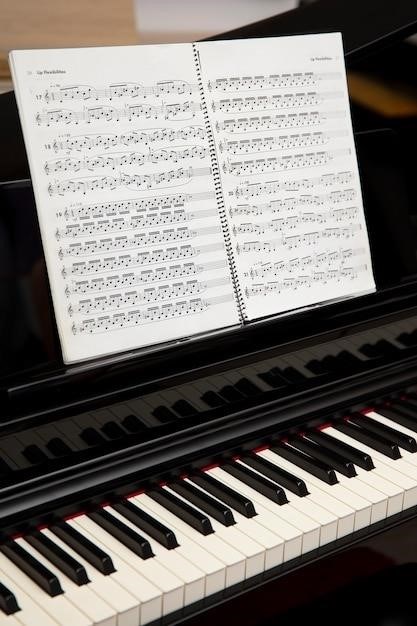All the Things You Are⁚ A Comprehensive Guide
This guide delves into the iconic jazz standard “All the Things You Are‚” exploring its rich history‚ lyrical depth‚ and enduring popularity․ We’ll examine its compositional intricacies‚ harmonic structure‚ and melodic nuances‚ offering insights for both performers and enthusiasts․ Discover resources for learning and performing this timeless classic‚ available in various formats‚ including PDF and MIDI sheet music․
The Song’s History and Composers
“All the Things You Are‚” a timeless jazz standard‚ boasts a captivating history interwoven with the talents of two musical giants⁚ Jerome Kern‚ the composer‚ and Oscar Hammerstein II‚ the lyricist․ The song’s creation occurred in 1939‚ emerging as part of the musical “Very Warm for May․” While the show itself enjoyed a relatively short run on Broadway‚ its legacy lives on primarily through the enduring popularity of this single composition․ Kern‚ celebrated for his prolific contributions to musical theatre and his innovative harmonies‚ masterfully crafted the song’s melodic framework․ Hammerstein II‚ known for his evocative and poignant lyrics in collaborations with Richard Rodgers (Oklahoma!‚ The Sound of Music)‚ contributed the lyrics‚ perfectly complementing the music’s elegant simplicity and emotional depth․ The collaboration between these two songwriting legends resulted in a song that transcended its theatrical origins to become a cornerstone of the jazz repertoire‚ captivating audiences for generations․
The Lyrics and Their Meaning
Oscar Hammerstein II’s lyrics for “All the Things You Are” are deceptively simple yet profound‚ painting a vivid portrait of love and longing․ The verses employ evocative imagery‚ comparing the beloved to natural phenomena⁚ the “promised kiss of springtime‚” the “breathless hush of evening‚” and the “angel glow that lights a star․” These metaphors transcend simple romantic declarations‚ suggesting a deeper‚ more spiritual connection․ The repetition of “all the things you are” emphasizes the multifaceted nature of the beloved‚ hinting at an inexhaustible well of qualities that inspire awe and adoration․ The subtle shift in tone from the tender descriptions to the hopeful anticipation of a future embrace (“someday my happy arms will hold you”) adds another layer of emotional depth․ The lyrics’ beauty lies in their ability to evoke a wide range of interpretations‚ allowing listeners to personalize the song’s meaning based on their own experiences of love and connection․ The ambiguity‚ a hallmark of Hammerstein’s style‚ allows the song’s emotional power to resonate universally․
Popular Interpretations and Recordings
“All the Things You Are‚” since its 1939 debut‚ has become a cornerstone of the jazz repertoire‚ attracting countless interpretations across various styles and eras․ Ella Fitzgerald’s rendition‚ a testament to her vocal prowess and phrasing‚ stands as a benchmark recording‚ showcasing the song’s lyrical elegance and melodic flexibility․ Countless jazz vocalists have embraced the song‚ each imparting their unique stylistic imprint․ Instrumental interpretations‚ however‚ demonstrate the song’s versatility․ From solo piano performances highlighting its harmonic complexity to big band arrangements emphasizing its rhythmic drive‚ “All the Things You Are” proves adaptable to diverse instrumental palettes․ Its enduring popularity is reflected in its frequent inclusion in jazz education curricula and its consistent presence in live performances worldwide․ The readily available sheet music‚ in various formats (PDF and MIDI)‚ contributes to its continuous accessibility‚ ensuring that this classic continues to inspire and challenge musicians and listeners alike․ The song’s enduring legacy is a testament to its compositional excellence and its capacity to evoke a wide spectrum of emotional responses․
Sheet Music and Arrangements⁚ Availability and Formats (PDF‚ MIDI)
The widespread accessibility of “All the Things You Are” sheet music significantly contributes to its enduring popularity․ Numerous online platforms and print publishers offer the song in various arrangements catering to different skill levels and instrumental combinations․ The readily available PDF format allows for convenient downloading and printing‚ making the sheet music easily accessible to musicians globally․ Furthermore‚ MIDI versions are available‚ enabling musicians to experiment with different tempos‚ instrumentations‚ and harmonic voicings using digital audio workstations (DAWs)․ These digital arrangements provide flexibility for both practice and performance‚ allowing for personalized interpretations and creative exploration․ The availability of both PDF and MIDI formats ensures that “All the Things You Are” remains a vibrant and accessible piece for musicians of diverse backgrounds and technical capabilities․ The diverse range of arrangements‚ from solo piano to big band scores‚ further enhances its versatility and appeal to a broad audience․
All the Things You Are in Jazz Education
“All the Things You Are” holds a prominent position within jazz education curricula worldwide․ Its sophisticated harmonic structure‚ complex chord progressions‚ and lyrical melodic contours provide invaluable learning opportunities for aspiring jazz musicians․ Students analyze its rich harmonic language‚ exploring ii-V-I progressions‚ alterations‚ and substitutions․ The song’s melodic phrasing challenges students to develop their improvisational skills‚ encouraging creative exploration of melodic ideas within the harmonic framework․ Its use in educational settings fosters a deep understanding of jazz harmony‚ rhythm‚ and improvisation․ Furthermore‚ the abundance of readily available sheet music and recordings facilitates both individual practice and ensemble performance‚ allowing students to develop their musical skills in diverse contexts․ The pedagogical value of “All the Things You Are” is undeniable‚ making it a cornerstone of jazz education programs at various levels‚ from introductory courses to advanced workshops․
The Song’s Structure and Harmonic Complexity
“All the Things You Are” boasts a sophisticated structure and harmonic complexity that distinguishes it as a challenging yet rewarding piece for musicians․ The song’s AABA form provides a foundational framework‚ yet the harmonic richness within each section elevates it beyond a simple pop tune․ The A sections feature intricate chord progressions built upon ii-V-I progressions in various keys‚ creating a sense of harmonic movement and tension․ These progressions are not merely simple repetitions; they are enriched by chromatic alterations‚ passing chords‚ and substitutions that add layers of harmonic interest․ The bridge (B section) offers a contrasting harmonic landscape‚ often deviating significantly from the A section’s tonality․ This contrast serves to heighten the overall musical experience and provides opportunities for creative harmonic exploration in improvisations․ The return to the A section after the bridge reinforces the song’s structure while maintaining the harmonic intrigue․ This sophisticated interplay of structure and harmony is what makes “All the Things You Are” a compelling piece for study and performance․
Melodic Analysis and Notable Phrases
The melody of “All the Things You Are” is instantly recognizable and exquisitely crafted‚ showcasing a graceful lyricism and memorable phrasing․ A careful melodic analysis reveals a sophisticated construction‚ utilizing stepwise motion‚ leaps‚ and rhythmic variation to create a captivating melodic line․ The opening phrase‚ with its gentle ascent and descent‚ immediately establishes a lyrical mood‚ while subsequent phrases build upon this foundation with subtle variations and unexpected turns․ Notable melodic features include the use of sequential patterns‚ creating a sense of continuity and unity across different sections; The song’s memorable phrases are not only pleasing to the ear but also lend themselves beautifully to improvisation․ Specific motifs‚ such as the descending chromatic line in the bridge‚ provide fertile ground for melodic development and embellishment․ The interplay between the main melody and the countermelody further adds to the song’s melodic richness․ This intricate interplay of melodic elements contributes significantly to the song’s enduring appeal and makes it a rewarding subject for musical study․
Improvisational Possibilities and Common Approaches
“All the Things You Are” presents a wealth of improvisational opportunities for musicians across various instruments․ Its sophisticated chord changes and melodic contours provide a fertile ground for creative exploration․ Common improvisational approaches often center on outlining the chord changes‚ employing arpeggios‚ and using passing tones to navigate the harmonic landscape․ The song’s structure allows for both lyrical and rhythmically driven solos‚ catering to diverse stylistic preferences․ Many improvisers focus on developing melodic ideas from the original theme‚ creating variations and extensions of existing motifs․ The use of chromaticism‚ particularly in the bridge section‚ offers compelling avenues for creating tension and release․ Furthermore‚ incorporating blues scales and altered dominant chords adds a layer of harmonic richness and complexity to the improvisation․ Experienced jazz musicians might explore advanced techniques such as altered dominant substitutions‚ quartal harmony‚ and extended chords to craft unique and expressive improvisations․ The versatility of “All the Things You Are” makes it a staple in jazz education‚ providing endless possibilities for musical exploration and self-expression․
All the Things You Are in Different Instruments and Settings
The adaptability of “All the Things You Are” shines through its versatility across various instrumental settings․ While commonly arranged for piano‚ its melodic and harmonic complexity translates beautifully to other instruments․ From solo piano performances showcasing intricate voicings and improvisations to full big band arrangements highlighting intricate ensemble work‚ the song adapts seamlessly․ Smaller ensembles‚ such as trios or quartets‚ can emphasize the intimate interplay between instruments‚ focusing on the delicate balance of melody and harmony․ The song’s structure also lends itself well to orchestral adaptations‚ enriching the texture and emotional depth․ Furthermore‚ the song’s enduring popularity is reflected in its presence in various musical contexts‚ from intimate jazz clubs to grand concert halls․ The sheet music’s widespread availability in multiple formats like PDF and MIDI has also contributed to its cross-instrumental appeal․ Whether it’s a solo saxophone rendition emphasizing lyrical phrasing or a guitar arrangement highlighting its harmonic richness‚ “All the Things You Are” consistently captivates audiences regardless of the chosen instrumental palette or performance setting․
Resources for Learning and Performing the Song
Numerous resources are available for those wishing to learn and perform “All the Things You Are․” Countless websites offer sheet music in various formats‚ including readily downloadable PDFs and MIDI files catering to different skill levels and instrumental choices․ These digital resources often include lead sheets with chord symbols‚ facilitating improvisation and personal interpretation․ Printed editions‚ readily accessible through online retailers and music stores‚ provide a tangible learning experience․ Many jazz method books incorporate “All the Things You Are” as a standard study piece‚ providing structured exercises and analysis․ Online platforms host video tutorials and masterclasses by renowned jazz musicians‚ offering valuable insights into the song’s phrasing‚ harmony‚ and improvisational potential․ These videos often demonstrate different approaches to the melody and accompaniment‚ enriching the learning process․ Furthermore‚ countless recordings by legendary jazz artists provide inspiring interpretations and demonstrate various stylistic approaches to the song‚ making them essential listening for aspiring musicians․ These combined resources provide a comprehensive pathway for both beginners and experienced musicians seeking to master this classic jazz standard․


